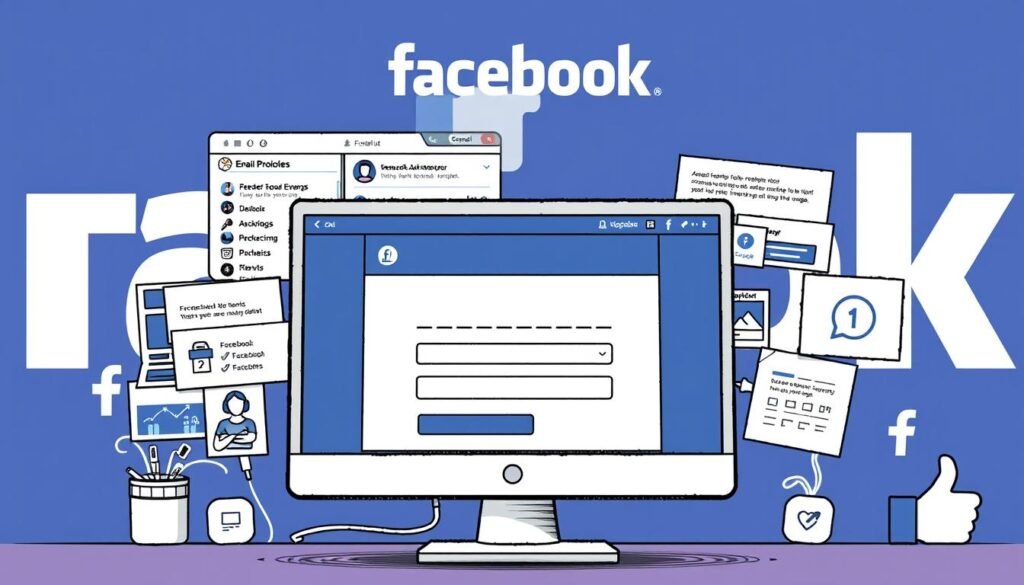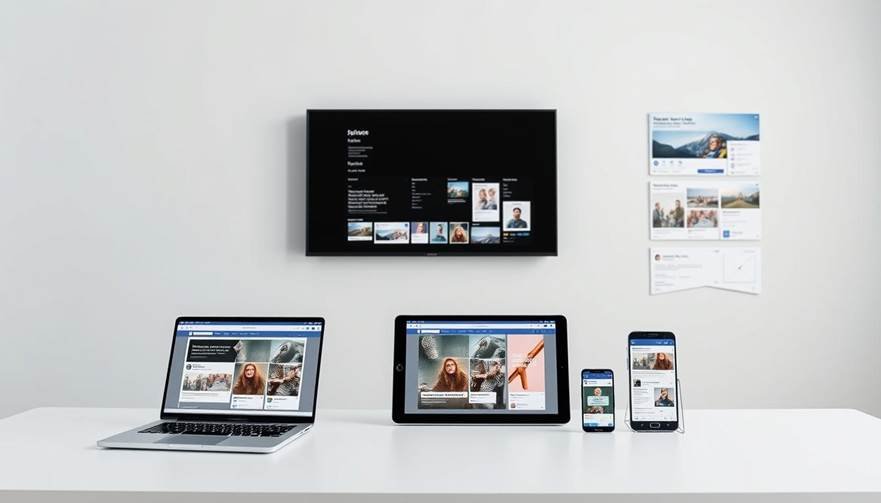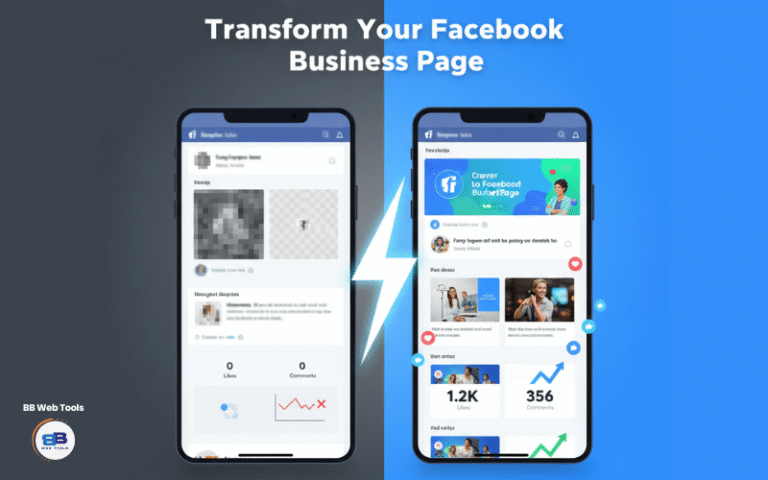Want to unlock the full potential of Facebook ads for profit? You’re not alone—many businesses struggle to turn clicks into revenue, while others consistently generate high returns. The difference? A strategic approach to profitable Facebook ads that maximizes every dollar spent.
With over 3 billion monthly active users, Facebook (Meta) is more than just a social network; it’s a goldmine for businesses. In 2023 alone, Meta generated $134.9 billion, with 98% of the revenue coming from ads. The opportunity is massive, but so is the competition.
So, how do you stand out?
- Are your Facebook ad strategies tailored for conversions or just engagement?
- Do you know which Facebook ad campaigns drive the most sales?
- Could you miss hidden tweaks that boost ROI with Facebook ads?
In this guide, you’ll discover data-backed tactics to create high-converting Facebook ads, whether you’re a startup or an established brand. Let’s turn your ad spending into real profits.
Disclosure: BBWebTools.com is a free online platform that provides valuable content and comparison services. To keep this resource free, we may earn advertising compensation or affiliate marketing commissions from the partners featured in this blog.

Key Takeaways
- Social media advertising is a powerful tool for reaching a global audience.
- Meta’s dominance in the market makes it a key platform for business growth.
- Effective ad strategies can significantly boost conversion rates.
- Proper ad management can triple sales and improve ROI.
- Learning from real-world examples can help you avoid common pitfalls.
Why Facebook Ads Are a Game-Changer for Your Business
With billions of users online, social media platforms have become a cornerstone of modern marketing. Among these, Meta’s family of apps—including Facebook, Instagram, and Messenger—dominate the digital landscape. These platforms offer unparalleled access to a global audience, making them essential for businesses aiming to expand their reach.
The Power of Facebook’s Advertising Reach
Meta’s platforms collectively boast over 3 billion active users. This massive audience encompasses a diverse range of demographics, interests, and behaviors. For businesses, this means the ability to target specific groups with precision and accuracy. Whether you’re promoting a product or building brand awareness, the reach of these media platforms is unmatched.
One of the standout features is the advanced targeting options. You can tailor your campaigns based on age, location, interests, and even purchasing behavior. This level of customization ensures your message reaches the right people at the right time.
“Meta’s advertising ecosystem is designed to help businesses connect with their ideal audience in meaningful ways.”
How Meta Makes Money from Ads
Meta’s revenue model is heavily reliant on its advertising space. In 2023, the company generated $133 billion, with 99% of this coming from ads. The auction-based system allows advertisers to bid for ad placements, with costs determined by CPC (cost-per-click) or CPM (cost-per-thousand impressions).
Instagram, in particular, has become a hub for product discovery. Its visually-driven format makes it ideal for showcasing goods and services. Meanwhile, WhatsApp and Messenger are increasingly being used for customer service and engagement, adding another layer to Meta’s monetization strategies.
| Platform | Key Feature | Revenue Contribution |
| Massive user base | Primary revenue driver | |
| Visual storytelling | Growing ad revenue | |
| Messenger | Customer engagement | Emerging monetization |
Despite its success, Meta faces challenges. Reality Labs, its metaverse division, reported a loss of $16 billion in 2023, despite generating $1.9 billion in revenue. Additionally, regulatory scrutiny, such as the EU’s $414 million fine for privacy violations, underscores the importance of transparency in data usage.
By understanding these dynamics, businesses can leverage Meta’s platforms to create impactful campaigns that drive results. Whether through carousel ads or precise targeting, the opportunities are vast.
Setting Up Your Facebook Ads Manager Account
To elevate your marketing game, setting up the right tools is essential. The Facebook Ads Manager is a robust platform that helps you create, manage, and optimize campaigns. Let’s walk through the steps to get started.
Creating a Business Manager Account
First, visit business.facebook.com/create to set up your Business Manager account. This central hub allows you to manage multiple ad accounts, pages, and team members. Follow these steps:
- Sign up with your business email and verify your account.
- Add your business details, including name and address.
- Set up team permissions for collaborative management.
Once done, you’ll have a streamlined workspace to take your business to the next level.
Navigating the Ads Manager Interface
The Ads Manager interface is designed for efficiency. Familiarize yourself with its key tabs:
- Campaigns: Create and monitor your ad campaigns.
- Audiences: Define and refine your target groups.
- Budget: Set daily or lifetime budgets for your ads.
Mastering these tabs ensures smooth campaign execution and better results.
Connecting Your Payment Method
To run ads, you’ll need to connect a payment method. Ads Manager supports multiple options, including credit cards and PayPal. Here’s how:
- Go to the Payment Settings section in Ads Manager.
- Add your preferred payment method securely.
- Set up two-factor authentication (2FA) for added security.
Understanding daily vs. lifetime budget options helps optimize cash flow and campaign performance.
“Proper setup is the foundation of successful advertising. Take the time to configure your account correctly.”
By following these steps, you’ll be ready to launch effective campaigns and achieve measurable growth.
Defining Your Ideal Audience for Facebook Ads
Finding the right audience is the cornerstone of any successful campaign. Without precise targeting, even the most creative content can fall flat. To maximize your reach and engagement, it is essential to understand who your ideal audience is and how to effectively connect with them.
Understanding Audience Targeting Options
Meta’s platforms offer a range of targeting options to help you narrow down your audience. You can layer demographics, such as age and location, with behavioral data for greater precision. For example, a bakery might target users who follow competitors, offering free goods to attract their attention.
Another powerful strategy is to create lookalike audiences from your top-performing converters. This approach helps you reach people who share similar interests and behaviors with your existing customers. Retargeting website visitors is also effective, as these users have already shown interest in your brand.
How to Create Custom Audiences
Custom audiences allow you to tailor your campaigns to specific groups. Start by building audiences from your email lists or excluding existing customers to focus on new leads. Location targeting is beneficial for local businesses, as it ensures your ads reach the right geographic area.
Combining interest categories creatively can also yield great results. For instance, a fitness brand might target users interested in both yoga and healthy eating. Regularly analyzing audience insights reports helps refine your strategy over time.
| Targeting Strategy | Best Use Case | Example |
| Demographic Layering | Local Businesses | Bakery targeting nearby users aged 25-40 |
| Lookalike Audiences | Scaling Campaigns | E-commerce store targeting similar shoppers |
| Retargeting | Boosting Conversions | Retargeting cart abandoners |
Testing layered versus broad targeting can help you determine the optimal approach for your campaigns. Remember to refresh your audiences quarterly to keep your strategy aligned with changing consumer behaviors.
Choosing the Right Facebook Ad Format
Selecting the perfect ad format can make or break your campaign’s success. Each format serves a unique purpose, and understanding their strengths can help you achieve better results. Whether you’re driving traffic, showcasing digital products, or building brand awareness, the right choice can significantly boost your conversion rates.

Link Click Ads
Link click ads are ideal for driving traffic to your website or landing page. To maximize their effectiveness, ensure your landing page aligns with the ad’s message. Use clear and compelling calls-to-action (CTAs) to encourage users to click. Testing different CTAs and visuals can help you identify what resonates best with your audience.
Optimize for mobile users, as most traffic comes from smartphones. Keep your copy concise and focus on the value your audience will gain by clicking through.
Video Ads
Video ads are highly engaging and perform best when kept under 30 seconds. Create snackable content that grabs attention within the first few seconds. Use storytelling to emotionally connect with your viewers and effectively highlight your product’s benefits.
Include captions for silent autoplay scenarios, as many users watch videos without sound. Test different video lengths and formats to determine which ones drive the highest engagement.
Carousel Ads
Carousel ads allow you to showcase up to 10 products or images in a single ad. Use this format to tell a product story or highlight multiple features of a single item. Each card should flow seamlessly into the next, creating a cohesive narrative.
Experiment with different layouts, such as mixing images and videos, to determine which one performs best. Use clear CTAs on each card to guide users through the carousel.
| Ad Format | Best Use Case | Key Tip |
| Link Click Ads | Driving Traffic | Align the landing page with the ad message |
| Video Ads | Engagement | Keep videos under 30 seconds |
| Carousel Ads | Product Showcase | Create a cohesive narrative |
By selecting the right format and adhering to these best practices, you can create Facebook campaigns that yield measurable results. Test different formats and analyze performance metrics to refine your strategy over time.
Setting a Budget for Your Facebook Ads
A well-planned budget is the backbone of any successful campaign. Whether you’re a small business or a large enterprise, understanding how to allocate your resources can make a significant difference in your results. Begin by determining whether to allocate a daily or lifetime budget, based on your campaign objectives.
Daily vs. Lifetime Budgets
A daily budget sets a limit on how much you’re willing to spend per day. For example, a $100 daily budget ensures your spending stays consistent. On the other hand, a lifetime budget spreads your total spend over the entire campaign duration. Choose daily budgets for short-term campaigns and lifetime budgets for longer ones.
Consider your audience’s location when setting budgets. In the US and Canada, the average revenue per user (ARPU) is $68, compared to $4.50 elsewhere. This means you may need to allocate more funds in high-value regions to maximize returns.
How to Allocate Your Budget Effectively
Effective budget allocation starts with calculating your break-even ROAS (Return on Ad Spend). This helps you understand how much revenue you need to generate to cover your advertising costs. Implement the 70/30 rule—allocate 70% of your budget to proven strategies and 30% to testing new ideas.
Use bid caps to control costs and adjust budgets based on dayparting (peak activity times). Allocate more funds to top-performing ads and reallocate underperforming funds to better-performing campaigns. Seasonal fluctuations should also be taken into account to ensure your budget aligns with demand.
- Monitor frequency metrics to avoid ad fatigue.
- Utilize campaign budget optimization to automate allocation decisions.
- Balance prospecting and retargeting spend for a well-rounded strategy.
By following these techniques, you can optimize your budget and achieve better results from your campaigns.
Creating High-Converting Facebook Ads for Profit
Creating ads that convert requires a mix of creativity and strategy. Your goal is to capture attention, establish trust, and prompt action. Whether you’re aiming to boost sales or build your brand, the right approach can make all the difference.
Writing Compelling Ad Copy
Start with headlines that address your audience’s pain points. For example, “Tired of Overpaying? Save Big Today!” instantly grabs attention. Use emotional language to connect with your audience. Studies show that emotional copy increases conversions by 27%.
Incorporate social proof, such as testimonials, to establish trust and credibility. Highlight product features and benefits. For instance, “Our ergonomic design reduces back pain by 50%” is more compelling than a generic description.
Add urgency triggers, such as “Limited Time Offer,” to encourage immediate action. Test emojis versus plain text to see what resonates best with your audience. Localize your content for different regions to make it more relatable.
Using Visuals to Grab Attention
Visuals are a powerful tool for engagement. Research shows that visual ads receive 3 times more engagement than text-only ads. Use high-quality images or videos that highlight your product’s benefits.
Design color-contrast CTAs to make them stand out. For example, a bright orange button on a blue background is hard to miss. Optimize for sound-off viewing by adding captions to your videos.
Refresh your creatives every two weeks to avoid ad fatigue. Use branded content tags to maintain consistency and reinforce your brand identity.
| Visual Tip | Best Use Case |
| Color-Contrast CTAs | Increase click-through rates |
| Captions in Videos | Engage sound-off viewers |
| High-Quality Images | Showcase product benefits |
By combining compelling copy with eye-catching visuals, you can create ads that not only grab attention but also drive meaningful results. Test different approaches and analyze performance to refine your strategy over time.
Launching Your First Facebook Ads for Profit Campaign
Launching your first campaign can feel overwhelming, but with the right steps, it’s easier than you think. Whether you’re new to Facebook advertising or looking to refine your approach, a structured process is essential for success. Follow this guide to set up, test, and optimize your campaigns for maximum impact.
Step-by-Step Guide to Campaign Setup
Start by completing a campaign setup checklist. This includes defining your goals, selecting your audience, and choosing the proper ad format. Implementing conversion tracking is crucial to measure success. Tools like the Facebook Pixel help you understand how users interact with your ads.
Launch small-scale tests first. Begin with budgets as low as $5/day to minimize risk while gathering data. Analyze the initial 48-hour results to identify trends and areas for improvement. This approach allows you to refine your strategy before scaling up.
- Define clear campaign objectives.
- Set up conversion tracking tools.
- Start with small budgets to test effectiveness.
- Monitor early performance metrics closely.
Testing and Optimizing Your Ads
Optimization is key to running ads that deliver results. Focus on achieving the lowest cost per result by adjusting bids and targeting. Utilize automated rules to efficiently manage bids, saving time while maintaining control over your budget.
Test 3-5 ad variations to determine which one resonates best with your audience. Monitor frequency thresholds to prevent ad fatigue, which can lead to reduced engagement. Implement dayparting adjustments to show ads during peak activity times, maximizing visibility and conversions.
“Regular optimization ensures your campaigns stay effective and cost-efficient.”
- Test multiple ad creatives and formats.
- Adjust bids based on performance data.
- Schedule weekly optimizations for continuous improvement.
By following these steps, you’ll launch campaigns that not only perform well but also provide valuable insights for future growth. Remember, the key to success lies in testing, analyzing, and refining your approach.
Understanding Facebook Ads Profit Margins
Understanding your financial outcomes is crucial for sustainable growth. When running campaigns, it’s not just about generating clicks or impressions—it’s about ensuring your efforts translate into real profit. This section will guide you through calculating and optimizing your profit margins for better financial health.

What Is Profit Margin?
Profit margin is the percentage of total revenue that remains after deducting all costs. It’s a key metric to evaluate the efficiency of your campaigns. A higher margin means more money stays in your pocket, while a lower one indicates room for improvement.
How to Calculate Profit Margin for Ads
To calculate your profit margin, use this formula:
((Revenue – Cost) / Cost) * 100
For example, if your campaign generates $1,000 in revenue and costs $400, your profit margin is 150%. This means you’ve earned $1.50 for every dollar spent.
Here are some practical tips to track and improve your margins:
- Calculate gross vs. net margins to understand overall profitability.
- Factor in product COGS (Cost of Goods Sold) for accurate calculations.
- Track lifetime customer value to assess long-term profitability.
- Use Ads Manager reporting tools to monitor performance.
- Set ROAS (Return on Ad Spend) targets by product.
- Analyze attribution windows to gain a deeper understanding of customer journeys.
- Calculate breakeven points to ensure campaigns are sustainable.
- Include overhead costs for a comprehensive view.
- Monitor margin trends on a weekly basis to identify changes promptly.
- Adjust bids based on margins to optimize spending.
By focusing on these strategies, you can ensure that your campaigns not only drive traffic but also contribute to your bottom line. Regularly reviewing your financial metrics helps you make informed decisions and achieve long-term success.
Analyzing the Performance of Your Facebook Ads
Analyzing your campaign’s performance is the key to unlocking its full potential. By tracking the right metrics and interpreting the data, you can make informed decisions that drive better results. Whether you’re new to the ads manager or a seasoned marketer, understanding these insights is crucial for success.
Key Metrics to Track
To evaluate your campaign’s effectiveness, focus on these essential metrics:
- CTR (Click-Through Rate): Measures the frequency at which people click on your ad. A higher CTR indicates better engagement.
- CPC (Cost Per Click): Tracks the cost of each click. Lower CPC means more efficient spending.
- CPM (Cost Per Thousand Impressions): Shows the cost of reaching 1,000 users. Useful for brand awareness campaigns.
- ROAS (Return on Ad Spend): Calculates the revenue generated for every dollar spent. A higher ROAS means better profitability.
Facebook’s global ARPU (Average Revenue Per User) is $13.12, making it a valuable media platform for advertisers. By monitoring these metrics, you can identify what’s working and what needs improvement.
How to Interpret Ad Performance Data
Interpreting data helps you refine your strategy. Start by analyzing click-through quality to ensure your audience is genuinely interested in your content. Track conversion paths to understand how users move from clicking your ad to making a purchase.
Compare CPC across placements to identify the most cost-effective options. Calculate engagement rates to see how well your content resonates. Review quality ranking scores to ensure your ads meet platform standards.
“Data-driven decisions are the foundation of successful campaigns. Regularly review your metrics to stay ahead.”
Set up automated alerts for negative feedback or sudden changes in performance. Export custom reports to share insights with your team. Benchmark your results against industry standards to gauge your campaign’s effectiveness.
By focusing on these strategies, you can optimize your campaigns and achieve measurable growth. Remember, the key to success lies in continuous analysis and improvement.
Scaling Your Profitable Facebook Ad Campaigns
Scaling your campaigns effectively can transform your results from good to great. Once you’ve identified what works, the next step is to strategically expand your efforts. This ensures your campaigns remain profitable while reaching a broader audience.
When and How to Increase Your Budget
Scaling requires careful planning. Start by analyzing your current campaigns. If you’re achieving a 3x ROAS (Return on Ad Spend), it’s a strong indicator that you’re ready to scale. Gradually increase your budget by 10-20% weekly to avoid overspending.
Use Campaign Budget Optimization (CBO) to automate budget allocation across your best-performing ad sets. This ensures your funds are directed toward the most profitable campaigns. Monitor efficiency limits to ensure your cost per result stays within acceptable ranges.
Expanding Your Audience Reach
Expanding your audience is key to scaling. Lookalike audiences, which perform twice as well as standard targeting, are a great place to start. These audiences are built from your best customers, ensuring you reach people with similar behaviors and interests.
Gradually expand geotargeting to include new regions. Test interest category expansions to find untapped audiences. Balance broad targeting with detailed targeting to maximize reach while maintaining relevance.
“Scaling isn’t just about spending more, it’s about spending smarter.”
- Identify winning ad sets and duplicate them vertically.
- Leverage Advantage+ campaigns for automated scaling.
- Use dynamic creative testing to refine your ads.
- Reinvest profits strategically to fuel further growth.
By following these strategies, you can effectively and sustainably scale your campaigns. Remember, growth is a continuous process that requires regular analysis and adjustment.
Common Mistakes to Avoid in Facebook Advertising
Avoiding common pitfalls is essential for campaign success. Even minor errors can lead to significant losses, particularly when utilizing social media sites for marketing purposes. Let’s explore two critical mistakes and how to prevent them.
Overlooking Audience Targeting
One of the biggest mistakes is neglecting audience targeting. Studies show that 63% of failed campaigns don’t focus on this crucial step. Avoid using broad targeting defaults, as they can waste your budget on clicks that are irrelevant.
Refresh your exclusion lists regularly to ensure you’re not showing ads to the wrong people. Monitor frequency caps to prevent ad fatigue, which can lead to reduced engagement. Testing layered versus broad targeting can help you find the sweet spot for your campaigns.
“Precision in targeting ensures your message reaches the right audience at the right time.”
Ignoring Ad Performance Data
Another standard error is failing to analyze performance data. Surprisingly, 41% of marketers don’t review their data weekly. This oversight can lead to missed opportunities for optimization.
Track key metrics, such as CTR, CPC, and ROAS, to understand what’s working. Fix tracking discrepancies early to ensure accurate data. Schedule regular audits to keep your campaigns aligned with your goals.
- Update creatives to avoid fatigue and maintain engagement.
- Optimize landing pages to match your ad’s message.
- Balance testing budgets to explore new strategies without overspending.
By addressing these mistakes, you can ensure your campaigns are efficient, effective, and profitable. Remember, taking the time to refine your approach pays off in the long run.
Conclusion: Maximizing Profit with Facebook Ads
Taking your business to the next level requires a strategic approach and consistent effort. By implementing continuous testing and focusing on customer lifetime value, you can ensure sustainable growth. Automating reporting workflows and staying up-to-date on policy changes are essential ways to maintain efficiency.
Diversifying your ad formats and building brand equity can help you reach a broader audience. Reinvesting in top-performing campaigns and considering agency partnerships can further enhance your results. Tracking industry benchmarks and celebrating ROI milestones keeps your team motivated and aligned with your goals.
With proven strategies, your campaigns can achieve measurable success. Stay proactive, refine your approach, and watch your efforts translate into meaningful outcomes.
FAQ
Why should I use Meta’s advertising platform for my business?
Meta’s platform offers unmatched reach, allowing you to connect with billions of users across its family of apps, including Instagram. Its advanced targeting options ensure your message reaches the right people, making it a powerful tool for growth.
How do I set up a Business Manager account?
Go to the Business Manager page, click “Create Account,” and follow the prompts. You’ll need to enter your business name, email address, and other relevant details. Once set up, you can manage your campaigns and payment methods seamlessly.
What are the best ways to define my target audience?
Use the platform’s targeting features to focus on demographics, interests, and behaviors. You can also create custom audiences based on website visitors, email lists, or engagement with your content.
Which ad format should I choose for my campaign?
It depends on your goals. Link click ads drive traffic, video ads engage viewers, and carousel ads showcase multiple products. Choose the format that aligns with your campaign objectives.
How do I decide between a daily and lifetime budget?
A daily budget sets a limit for each day, while a lifetime budget spreads your spending over the entire campaign duration. Use daily budgets for consistent exposure and lifetime budgets for specific time-bound campaigns.
What makes an ad copy compelling?
Focus on clear, concise messaging that highlights benefits, not just features. Use a strong call-to-action and tailor your tone to resonate with your audience.
How do I launch my first campaign?
Start by selecting your objective in Ads Manager, defining your audience, setting your budget, and choosing your ad format. After launching, monitor performance and make adjustments as needed.
How do I calculate profit margins for my campaigns?
Subtract your total ad spend from your total revenue, then divide by the revenue and multiply by 100. This provides the profit margin percentage, enabling you to measure your success.
What metrics should I track to analyze performance?
Focus on conversion rates, click-through rates, and cost per result. These metrics provide insights into how well your ads are performing and where improvements are needed.
When should I scale my campaigns?
Scale when you see consistent positive results. Gradually increase your budget and expand your audience to maximize reach while maintaining profitability.
What are the common mistakes to avoid in advertising?
Avoid poor audience targeting and ignoring performance data. Constantly refine your strategy based on insights to ensure your campaigns remain effective.



